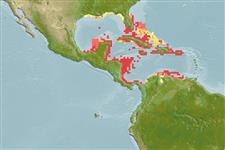Environment: milieu / climate zone / depth range / distribution range
Ecologia
marinhas associadas(os) a recifes; intervalo de profundidade 0 - 9 m. Subtropical; 33°N - 25°S, 95°W - 65°W
Western Atlantic: Bermuda, southern Florida (USA), Bahamas, and Yucatan (Mexico) to the Antilles (Ref. 26340) and northern South America.
Tamanho / Peso / Idade
Maturity: Lm ? range ? - ? cm
Max length : 102 cm TL macho/indeterminado; (Ref. 7251)
Light brown to grayish brown, darker above, with pale spots (Ref. 26938).
Commonly encountered swimming near the bottom in clear water from harbors to reefs. More common along continent and in grassy areas (Ref. 7251). Found in shallow areas to depths of 9 m. Feeds mainly on crabs. (Ref. 26938).
Ciclo de vida ou comportamento de acasalamento
Maturities | Reprodução | Spawnings | Egg(s) | Fecundities | Larvas
Distinct pairing (Ref. 205).
Robins, C.R., R.M. Bailey, C.E. Bond, J.R. Brooker, E.A. Lachner, R.N. Lea and W.B. Scott, 1991. Common and scientific names of fishes from the United States and Canada. Am. Fish. Soc. Spec. Publ. (20):183 p. (Ref. 3814)
Status na Lista Vermelha da UICN (Ref. 130435)
Ameaça para os humanos
Harmless
Uso pelos humanos
Ferramentas
Relatórios especiais
Baixar XML
Fontes da internet
Estimates based on models
Preferred temperature (Ref.
123201): 26.1 - 28.3, mean 27.5 °C (based on 435 cells).
Índice de diversidade filogenética (Ref.
82804): PD
50 = 0.5005 [Uniqueness, from 0.5 = low to 2.0 = high].
Bayesian length-weight: a=0.00089 (0.00039 - 0.00204), b=3.00 (2.80 - 3.20), in cm total length, based on LWR estimates for this (Sub)family-body shape (Ref.
93245).
Nível Trófico (Ref.
69278): 3.5 ±0.5 se; based on diet studies.
Resiliência (Ref.
120179): médio(a), tempo mínimo de duplicação da população 1,4 - 4,4 anos (Preliminary K or Fecundity.).
Fishing Vulnerability (Ref.
59153): High vulnerability (61 of 100).
Nutrients (Ref.
124155): Calcium = 22.6 [9.9, 50.3] mg/100g; Iron = 0.489 [0.252, 0.990] mg/100g; Protein = 19.6 [17.3, 22.1] %; Omega3 = 0.13 [0.05, 0.36] g/100g; Selenium = 15.6 [7.4, 38.2] μg/100g; VitaminA = 28.2 [7.1, 106.3] μg/100g; Zinc = 0.643 [0.414, 1.011] mg/100g (wet weight);
